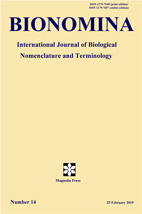Abstract
The Code provides no Rules regarding the taxonomic allocation and nomenclatural validity of class-series nomina (for taxa above the rank superfamily), which results in considerable confusion, arbitrariness and instability in higher zoological nomenclature. Currently, authors are ‘free’ to use any system or no system at all, and the only way to provide clear and unambiguous information about the status of such nomina in a given work is to provide explicit information on the Criteria used. Such Criteria should have a general value over the whole zoological nomenclature and should not be devised on the basis of a limited knowledge of the literature bearing on a single animal group like the amphibians.
Several questions related to higher nomenclature are discussed again in detail here: e.g., the acceptance of nomenclatural availability, with their original authorship and date, of class-series nomina introduced as clear scientific names, derived from classical Greek or Latin roots, even in a ‘non-Latin’ form (an unclear concept), or the statement that the rank of a taxon in the work where a new nomen was introduced is a reliable criterion for the assignment of this nomen to a nominal-series only when it concerns the five basic ranks of the Linnean hierarchy, which are the only ones to have always been used for the same position in the taxonominal hierarchy. The proposals made here are not ‘official’, but, as long as no Rules are implemented in the Code in these respects, this also applies to any other proposals, many of which are not even supported by clear statements about consistent Criteria that could be used for higher nomenclature in all animal groups.
These general questions are here discussed based on real examples from amphibian higher nomenclature. Dubois (2004) provided a detailed analysis of the higher nomenclature of recent amphibians. Almost immediately after its publication, Frost et al. (2006) rejected all the conclusions of this work. Although all their arguments were refuted in detail by Dubois in several publications, the widely cited and followed website Amphibian Species of the World (ASW) stuck to their opinions, but without providing replies to these criticisms, without providing a complete and consistent rationale for higher nomenclature, and above all, in the absence of arguments, in repeating factual errors. This is shown in detail here with the examples of the nomina of the two orders of recent amphibians accommodating the frogs and the salamanders. Frost et al. (2006), followed by ASW and by several recent authors and websites, credited the nomina Anura, Urodela, Ecaudata and Caudata to ‘Fischer von Waldheim (1813)’, but it is shown here that this is incorrect, for several reasons: [1] this statement is anachronistic, as Gotthelf Fischer (1771–1853) was granted the nobiliary title ‘von Waldheim’ only in 1835 and never used it in the signature of his publications; [2] the nomina used by Fischer (1813a) for the frogs and the salamanders were not new nomina, but explicit subsequent usages, without any change in rank, of the nomina of Duméril (1805); [3] under a nomenclatural system compatible with the Code, the nomen Urodela Duméril, 1805, instead of Caudata Duméril, 1805, should be considered the valid one for the order of salamanders.
Additional examples of widely repeated errors in the citation of the authorship of other amphibian nomina in ASW are pointed out, such as the use of the incorrect transliteration of the name “Татаринов”, the italic writing of “Татаринов” (Tatarinov), as Tamarunov.
Finally, we address the question of the use of the ‘principle of authority’ in science.

